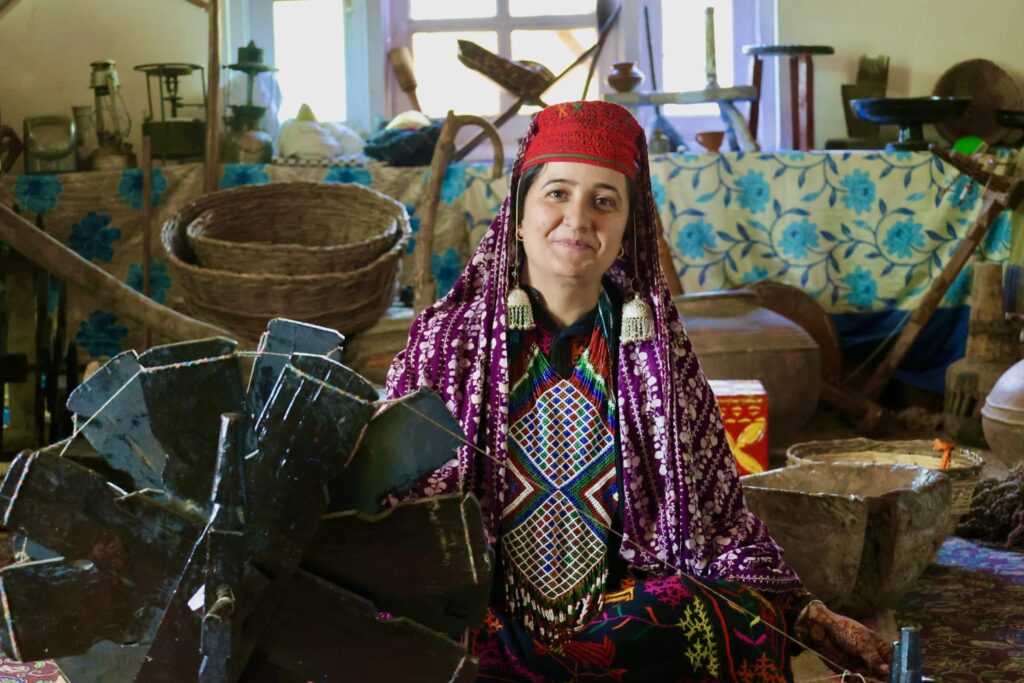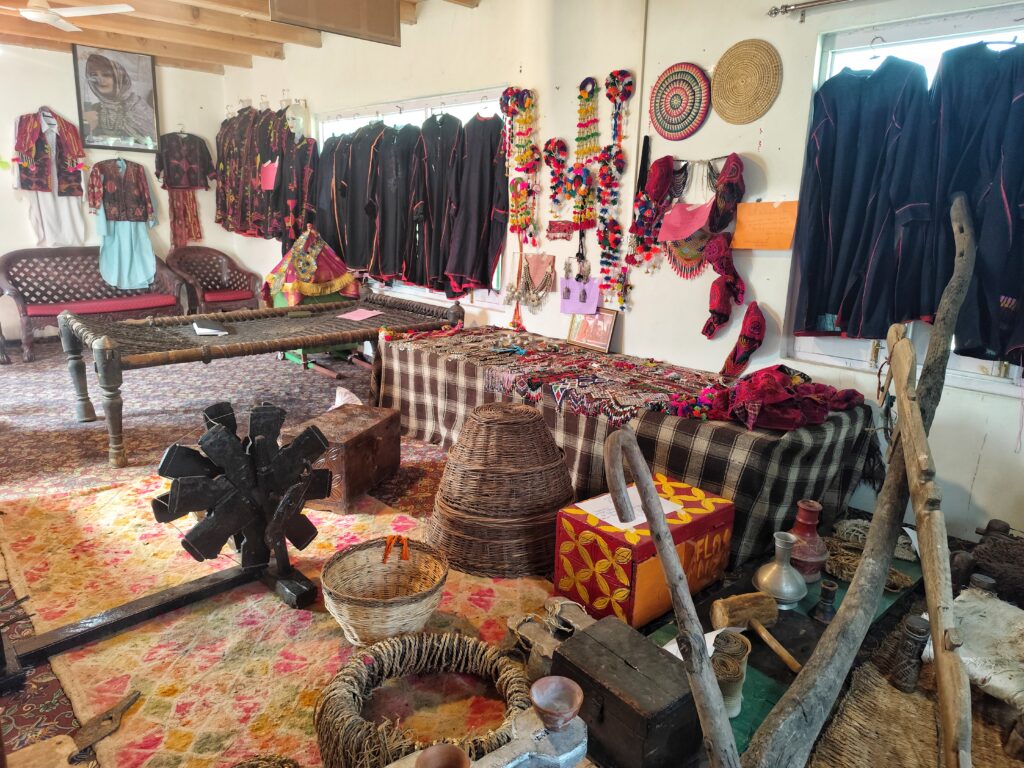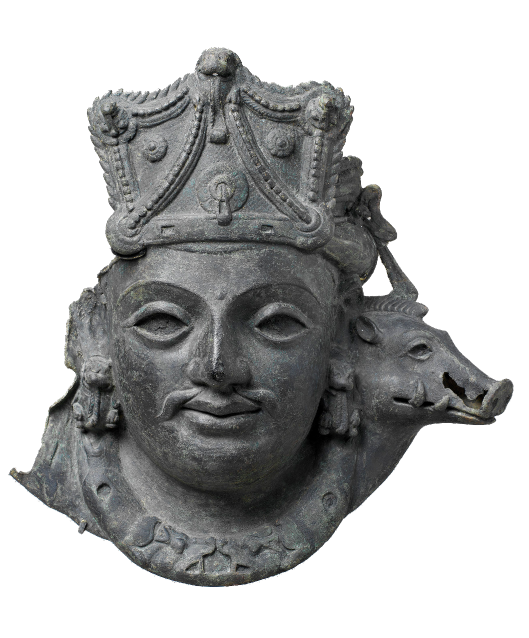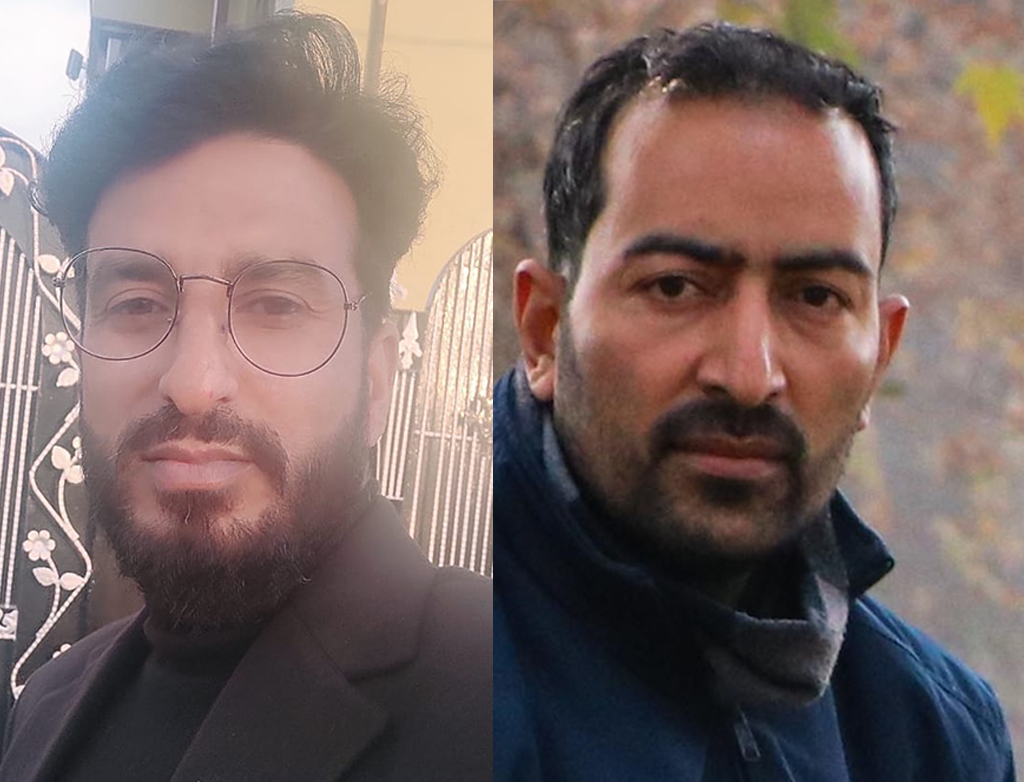PERSPECTIVES
Museum of Memories: Community-Led Preservation of Kashmir’s Gojri Heritage
In north Kashmir’s Aragam village in Bandipora district, a quiet experiment by one woman, which began in December 2022, has taken root. The modest-looking Kashmir Tribal Arts Society Museum (KTASM), established, curated, and run by Shahida Khanam, along with other members of the local Gojri tribe, is the Valley’s first “community-run museum.” It is dedicated to preserving the region’s heritage in ways that are meaningful to the Gojri-speaking people, who constitute the third largest linguistic group — after the Kashmiri (Koshur) and Dogri communities — in Jammu & Kashmir (J&K).
Inside the museum, instead of glass-enclosed artefacts on pedestals, you will find small mud brick shelves and wooden racks lined with everyday objects from tribal homes. A tripaye (three-legged tray) used to serve guests, a selection of traditional jewellery and a weathered tabakh (utensil), darkened by decades of wood smoke, are displayed on the shelves next to a chair carved from walnut. On one wall hangs a blanket handwoven by women of the Gojri community, while in another corner sits a charka (spinning wheel) next to a carry bag made of animal hide. The way the space is organised defies every normative prescription of what an archival project to document the heritage of a region and a community should look like.

Each object bears carefully handwritten labels in Urdu and Gojri, a tribal language spoken by more than 20 million people across India. These include members of the Gujjar and Bakarwal communities of J&K who, together, constitute the region’s largest Scheduled Tribe population. Khanam, a 28-year-old mother of two, says the idea behind establishing the museum was simple — their community should not wait for outsiders to preserve their history. “In a government museum, our things might be kept behind glass,” she says, arranging a set of traditional silver necklaces. “Here, they are still part of our lives.”
Unlike formal state institutions, KTASM has deep roots within the local community. The objects were either donated or collected from various homes in the neighbouring villages across Bandipora district. Many objects were given to Khanam personally by village elders and families, who had once used them regularly. From personal items, such as kameezes (traditional dresses for women) and men’s clothing like the vaskat and gulbandh to objects of daily use and decoration, such as shanks (plates), kothas (mud-house models), talvers (sword), gatkas (wooden sticks used in dance and combat), and khadas (handwoven carpets) – this community museum’s growing collection aims to document each and every aspect of the tribe’s culture, past and present.
“Each thing here has a name, a story, and a purpose,” says Khanam. “We wanted to create a museum that speaks about our people’s way of life.” Housed in a large hall of her own family home, next to a local Unani hospital, KTASM “looks” different because it is, conceptually, the opposite of a conventional museum space. Government and institutional museums draw on the normative models of conservation and preservation that have their roots in colonial archives and European “cabinets of curiosities” that emerged in the 16th century — the ones that housed rare objects taken from communities, most often without their consent. In such conventional archival spaces, artefacts are usually classified by time periods, geography, or their function, often cataloguing “dead” cultures, rather than “living” ones. Moreover, curators, who only have a theory-based understanding of these cultures, “interpret” the objects for visitors through labels and plaques.

But in the case of this tribal museum, community members and locals have helped Khanam curate the selection based on what these objects mean to them. How the collection has been categorised and displayed is also linked to the Gojri way of life. In the classification system adopted by Khanam, the exhibits are grouped — not by age or rarity — but by how they were used in everyday life, in the past and present.
For example, there are livelihood objects such as herding tools, and the charka; then come those artefacts that reflect domestic heritage, such as the tabakh (utensil), peeda (chair), and chader (blanket). The museum also has numerous wearable items, from traditional tribal dresses to different types of jumkas (earrings), guchas (beaded jewellery), dolada (long silver necklace), mehal (close fitting ornamental necklace), among other things. Other objects on display are markers of the language and memory associated with Gojri heritage, such as recordings of folk songs, proverbs, and Gojri poetry. Instruments of faith and tradition, including some old musical instruments, amulets, and festive artefacts, are also on display.
“Our ‘categories’ come from life, not from textbooks,” Khanam explains. “A tabakh isn’t just an object. It’s how families share food. A peeda is not just a piece of furniture; it is where elders sit to tell their stories,” she says. Collecting artefacts and traditional household items from the local community wasn’t easy. Khanam spent months walking to remote hamlets across Bandipora district in Kashmir, knocking on doors. Her aim? To persuade families and tribal elders to part with old items of heritage value that were gathering dust in their attics, forgotten. Even daily use objects like ghatti (or chatti) and madani, used to make lassi, or the traditional stone grinder, once commonplace, had fallen into disuse and neglect. “People would say: ‘Why keep this old thing? It is useless now,’” she recalls. “I would tell them: ‘If you throw it away, you are throwing away your story.’”
Some elders were emotionally attached to inherited household objects, especially those linked to familial memories. But eventually, many agreed to part with them because they wanted their heirlooms to be preserved as museum exhibits for posterity. Many helped label them, dictating Gojri spellings or telling tales of how an item was once made or used. Over time, the museum became a collective act of storytelling, showcasing aspects of old domestic life, art and craft, and heritage of the Gojri community.

“We have nothing in writing,” Khanam says. “Our history lives in what we made and what we wore, and what we used.” The museum space itself reflects this ethos. The walls are made from local materials, plastered with mud to maintain warmth. Inside, there are no glass barriers or polished showcases, and visitors are encouraged to touch and feel the items on display. The display design follows the layout of a typical local tribal house, rather than a more formal gallery grid. “It had to feel like home,” says Khanam. “Not like a place where our culture is being studied.”
To keep the museum financially sustainable, Khanam joined hands with seven tailoring centres, located in the neighbouring villages, where over 200 young women learn traditional dressmaking and embroidery. The centres double up as cultural classrooms where instructors teach Gojri songs, customs, and oral phrases. “When a girl stitches a Gojri kameez and wears it proudly, that is also a form of preservation,” she says. “This is not about skills alone. It is about having pride in our culture.”
When asked why she picked the name “Kashmir Tribal Arts Society Museum,” rather than naming it after the community, pat comes the reply. “If I had called it Gojri Museum, people might think it is small or too local. But this name helps us be seen. It makes it sound like we are part of the larger story of Kashmir.” The title also reflects inclusiveness. While the museum is rooted in Gojri heritage, it welcomes artefacts and items worth preserving from other tribal groups in the region too.

“We are not separate tribes. We are part of one cultural thread,” she adds. Despite its growing visibility, support from local authorities has been limited. Khanam has approached multiple officials in the past for support. In return, she has received several appreciation letters, but little tangible help. The museum runs on donations, exhibition earnings, and personal income. But recognition has begun to trickle in. Khanam has represented Kashmir’s tribal culture at events such as Jan Jatiya Diwas (Jammu, 2024) and Dhyan Chand Stadium Exhibition (Delhi, 2025). Most recently, in August 2025, she received an “Award of Appreciation” after local forest officials brought her work to the notice of an Expert Committee on the Forest Rights Act, who were surveying the area. Her journey, however, has been arduous because the community did not embrace her vision to begin with. “At first, people didn’t appreciate the work I was doing, but when they saw my efforts being covered in the press, they began to see value in what I do,” she says.
On some days, women gather in the courtyard of the museum to sing Gojri folk songs. On other days, students record elders narrating stories of migration, forest life, and festivals. Khanam plans to digitise the archive, and launch an online portal. She also wants to eventually collaborate with universities to document oral histories. “Language is where extinction begins,” she says. “If we lose our words, we lose everything.” In a world where museums often feel like silent vaults, Khanam wants the museum to thrive and become a site of cultural preservation with the active participation of local communities. “We are not just trying to save a dying culture,” she explains. “We are living it, and that is what keeps it alive.
Yaqoob Ali is an independent Kashmir-based journalist, covering multiple beats. Majid Maqbool is a Kashmir-based independent journalist and writer.




